2021人教版高一英语必修二全册课件【完整版】
- 格式:pptx
- 大小:42.41 MB
- 文档页数:316
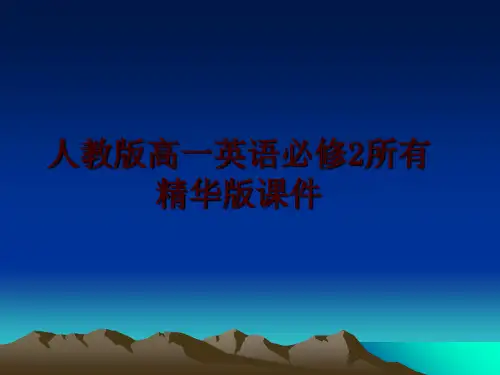
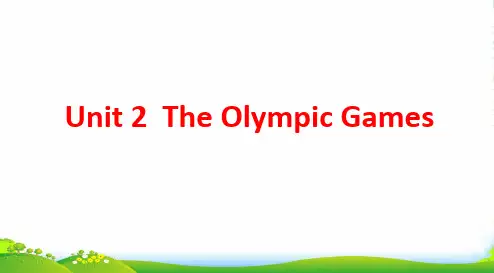

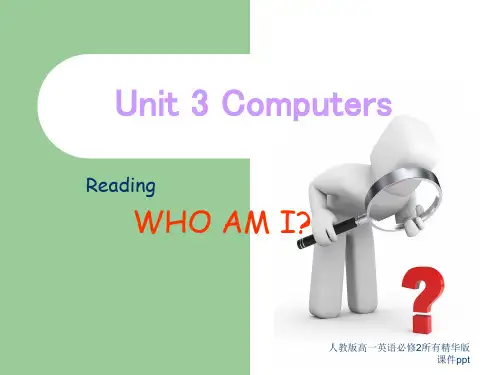
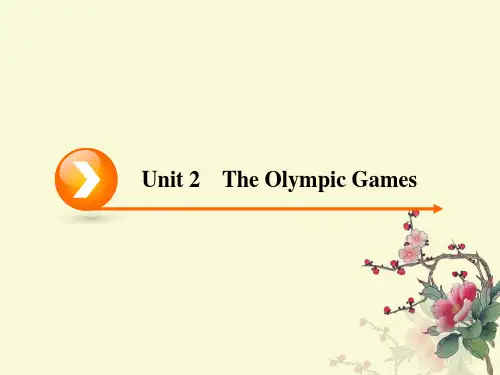
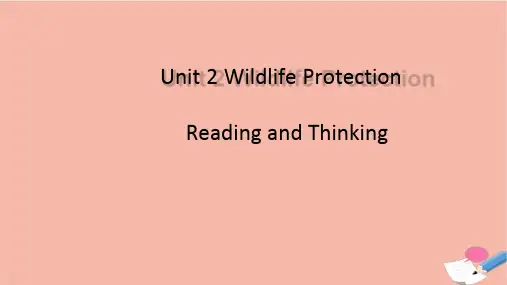
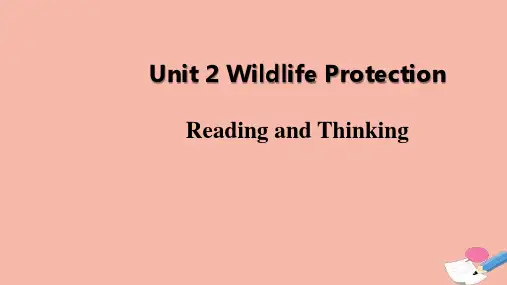
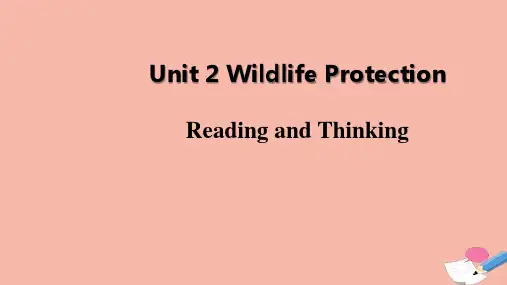
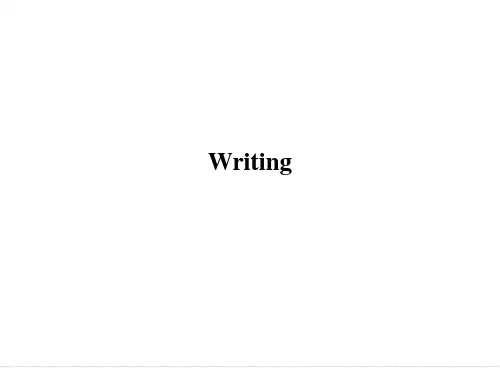
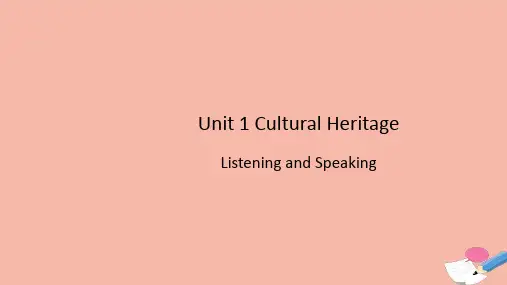
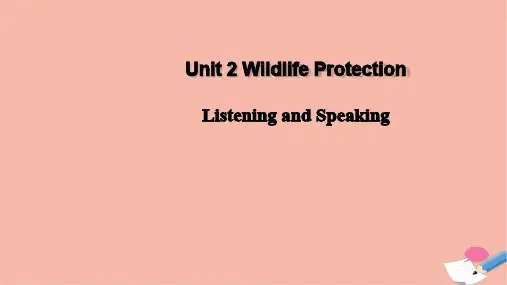
Unit 2 Wildlife Protection Listening and SpeakingTeaching objectives:n By the end of this period, you will be able to…1.know about the current situation and problems of wildlife.e visuals to predict content.3.voice your opinions on wildlife protection.4.talk about the living conditions and protection measuresof wildlife in simple English.Lead inLook and discuss about the opening page. Questions:1.What do you think of when you see this photo?2.Do you think that elephants are an endangered species?3.What other endangered animals can you think of when reading the quote?When the buying stops, the killing can too.---WildAidWarming upLook at the posters and answer the questions.1.What message do these posters share?The message of these posters is that wildlife is under threat.2.Which one moves you the most? Why?Features of a poster: large pictures; concise and powerful words; usage of figure of speech;careful design and use of colors, types of characters/letters…Listening tip:Use visuals to predict content-Before you listen,look at pictures,charts,videos,and other visuals to help youpredict what you will hear.PredictionPay attention to the new words:rate: a measurement of the speed at which sth. happensmass: a large number of; huge; seriousextinction: habitat:death of all its living membersnatural environment where animals live and growListen to the first part and check your answers.Our planet's __w_i_l d_l_if_e___ is dying out at an alarming rate. Between 150and 200 species are becoming extinct every day. This mass extinction is caused by hunting, habitat_______ and pollution. We must make peoplelossaware of the problem and help ___________ the endangered wildlife beforeprotectit's too late!Listen to the first part again and answer the following questions.1.How do they feel when they saw the poster?They feel scary and terrible.2. Why are so many species dying?Because they are being hunted and killed. And there’s pollution andhabitat loss.3. What should people do then?People should be more aware and help protect the wildlife.Listen to the second part and answer the questions.1. How many elephants are killed on average every day ?542. What did Prince William say about China ?BA. China has made a lot of progress.B. China can become a global leader in wildlife protection.C. China preserves its natural habitats well.Discuss the question in groups.What is said at the very end of the listening? What does it mean to you?“Change begins with you.”If we want things to change, we must change ourselves firstand not wait for others to change first. We must be the changewe want to see in the world.SpeakingLook at the pictures of3different kinds of animals.In pairs,discuss the questions and role-play the example.1. What do you know about the animals in the photos?2.What is being done to help them?Example:A: I’m concerned about the African elephants. What do youknow about them?animals B: Well, I know that they’re being hunted and their habitat isgetting smaller, so they’re in danger of extinction.Elephants need large living spaces, so it’s difficult for them to adapt to the changes. A: That’s terrible. What measures are being taken to help them?B: The authorities are under pressure to build elephant parks and tell people not to buy elephant products.problems measuresTalk about one of the animals in the photos. You can organize the information in this way:I’m concerned about…They are…(an animal) (problems)Some measures are being taken to help them. (measures)Possible versionA: I'm concerned about the blue whales. What do you know about them? B: Well, I know that they're being hunted and their number is getting dramatically smaller, so they're in danger of extinction. Blue whales need large and clear water habitats, so it's difficult for them to adapt to the changes.A: That's terrible. What measures are being taken to help them?B: The authorities are under pressure to make laws to ban illegal hunting whales and tell people not to buy whales products.1.Make a short conversation about one of the animals that you are concerned about.2.Review the new words learned from the listening material: rate,mass,extinction,habitat,etc.Thank you!。
Unit 1 Cultural Heritage Listening and SpeakingTake part in a youth projectHeritage is our legacy from the past, what we live with today, and what we pass on to future generations.---World Heritage CentreThe place in the photo is part of the Great Wall of China. It is made up from different sections of wall over 21.000 kilometres and was built over thousands of years. It runs across the historical northern border of China. It is one of the most famous places in the world and receives millions of visitors every year.The two children who are looking forward in awe along the wall may mean cultural heritage should be known to everyone in our country even very little children. It is everyone’s duty to protect cultural heritage. At the same time, the gate in the picture may represent the window to know about a country, through which we can know more about the country and even the world.3. What can we do to keep the heritage We should protect and promote the cultural heritage by doing many things such as repairing and makingdigital images and so on.generations?Task 1 Warming up1. Where do you think the students in Picture1 are?They are at the top of Mount Tai.2. Can you guess what they are doing?From the two pictures, we can guess after theyhave gathered information about Mount Tai,they are making a presentation and discussingabout Mount Tai.3. From the activity title “Take part in a youthBecause they are talking about something aboutMount Tai, which plays a very important role in ourculture, the project they are taking part in may beconcerned with the promotion and protection aboutMount Tai.Task 2 First listeningListen to the conversation, choose the main idea and tell me why.A. Students from different countries are working creatively to protect a temple in China.ouths from seven countries are working together to protect cultural relics on Mount Tai.C. Doing a project on cultural heritage protection in China is interesting and excitingTask 3 Second listeningListen again and try to answer the following questions.1.What are the students doing?They are creating an app about Mount Tai.2.What are they going to use the app for?They want to promote Mount Tai and use the app to teach teenagers about Mount Tai.3.What should they do to make the app?They should visit Mount Tai, take pictures, read about the mountain and write texts, visit local schools and talk to Chinese students.Task 4 Third ListeningListen again and help the reporter to complete the interview notes.an international youth project1. We're part of___________________________________.seven2. There are __2_3______ senior high school students from _________countries.3. Mount Tai is one of the most __f_a_m_o_u__s_____mountains in China.protected4. The mountain and the temples have been_____________ for over 3,000 years, so it's a great example of how people _p_r_e_s_e_r_v_e_______their cultural heritage. Weproudfeel so______________ to have a chance to do something.that is5. We want to ___p_r_o_m__o_t e_________Mount Tai;_________________, we want to tell teenagers in other countries about the mountain and Chinese culture.6. For example, this game is about the six cypresses that were planted on Mount Tai during the Han Dynasty. You learn about __t_h_e_t_r_e_e_s_______and also the life in China over 2,000years ago.temples stones7. There are 22___________ and some 1, 800 ____________with writing on them.Task 5 Skill-practice Try to guess the meanings of the underlined words and write them in the brackets. And then think about how you can guess the meanings.1.The palace was destroyed years ago . By studying o o l l d d p p h h o o t t o o s s of the like the old one former palace, they have made the new one look exactly like the old one.()先前的break 2.It will be very hard but also be very brittle---that is, it will break easily . (易碎的)3.The consequences of epochal events such as wars and great scientific discoveries are not confined to a small geographical area as they were in the past. (重大事件)4.Our maths teacher claims that all the problems he gives us are simple 难理解的ones, but we feel that they are intricate. ()5.Children often try to emulate or copy the behavior that they see on TV. (模仿)Step 2: Listening Task 6 Fourth ListeningListen to the conversation again and use the context to guess the meaning of the words below. Tick the reason why you were able to guess the words.Reason Preserve Promote CypressThe word is an example of a group/type I know. The word is explained by the speaker.ꢀꢀꢀꢀꢀꢀꢀꢀꢀꢀꢀꢀꢀꢀꢀꢀꢀꢀThe word means the opposite of a word I know. The word means the same as a word I know.I know the general meaning of the word.The speaker gives an example of the word.Step 2: Listening Task 7 SummaryHelp the reporter to complete the news report based on what you hear and the interview notes.International Youth Camp Members Create Mount Tai AppTai’an, 18 June 2019.A group of high school students whoare taking part in an international youth camp at Mount Taiare creating a(n)___a_p_p______about China's most famousmountain. The purpose of the camp is to _____________promoteMount Tai by introducing it to young people in a fun and easyway. The students are making an app about Mount Tai andtemplestaking photos of the ___________ and stones. Thevolunteers also visit middle schools in the area in order totalk to local teenagers. Liu Bin, a member of the camp, saysproudthat he is __________ to help Mount Tai as people havedone for more than 3,000 years.Task 1 Report BroadcastingMay Day is drawing near. Suppose you are a reporter, please imitate what a real reporter does to broadcast the above news to your classmates.Task 2 Discussion and TalkingWork in pairs, discuss the following questions and voice your opinion.1. Would you like to take part in a project like this? Why or why not?2. “The app teaches teenagers about Mount Tai and even has a few games about cultural relics”, what do you think of the idea of designing games? What other ways can you think of to protect the cultural heritage?。